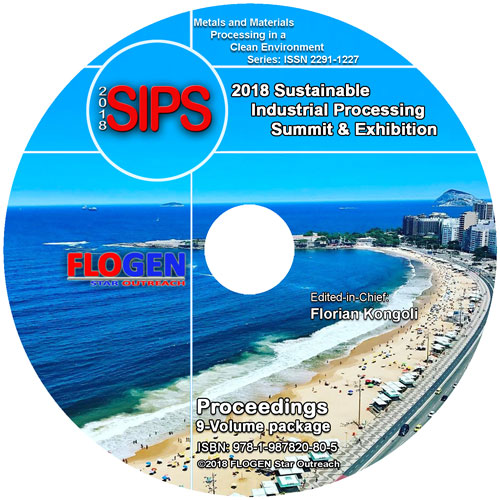2018-Sustainable Industrial Processing Summit
SIPS2018 Volume 2. Amatore Intl. Symp. / on Electrochemistry for Sustainable Development
| Editors: | F. Kongoli, H. Inufasa, M. G. Boutelle , R. Compton, J.-M. Dubois, F. Murad |
| Publisher: | Flogen Star OUTREACH |
| Publication Year: | 2018 |
| Pages: | 216 pages |
| ISBN: | 978-1-987820-84-3 |
| ISSN: | 2291-1227 (Metals and Materials Processing in a Clean Environment Series) |

CD shopping page
Nanospectroscopy for Electrochemistry-Electrochemical Tip-enhanced Raman Spectroscopy
Bin Ren1;1XIAMEN UNIVERSITY, Xiamen, China;
Type of Paper: Regular
Id Paper: 152
Topic: 47
Abstract:
Surfaces and interfaces play a key role in heterogeneous reactions. The electronic and geometric structure of the surface may significantly influence surface reactions. It is important for developing a method to probe the surface structure and the interaction of reactants or products with the active sites at the nanometer scale. In this regard, tip-enhanced Raman spectroscopy (TERS) appears to be an ideal tool.
We demonstrated that TERS can chemically and spatially resolve the site-specific electronic and catalytic properties bimetallic model catalysts of Pd or Pt on Au(111) with a spatial resolution of about 3 nm, using the vibrational fingerprints of phenyl isocyanide (PIC) adsorbed and reacted on the surface. The distinct chemical (electronic) and physical (plasmonic) properties of Pd or Pt steps compared with terraces have been directly visualized.
We further extend TERS to electrochemical systems for studying electrochemical surface and interfacial processes with the unique potential control over the sample. With the designed spectroelectrochemical cell, we were able to synergistically control the reaction by both electrode potential and laser power and characterize the reaction at the nanometer spatial resolution. The plasmon-induced reaction can lead to a reaction region of 30 nm in radius, which equals the mean free path of electron in Au. We further used TERS to characterize the defects of MoS2 with a spatial resolution better than 10 nm and combined electrochemistry to reveal the evolution of the active sites during electrocatalytic processes.
Keywords:
Physical electrochemistry; Raman enhanced plasmonics; Surface reaction mechanisms;References:
[1] J. H. Zhong, X. Jin, L. Meng, X. Wang, H. S. Su, Z. L. Yang, C. T. Williams, B. Ren, Nat. Nanotech. 2017, 12, 132.[2] Z. C. Zeng, S. C. Huang, D. Y. Wu, L. Y. Meng, M. H. Li, T. X. Huang, J. H. Zhong, X. Wang, Z. L. Yang, B. Ren, J. Am. Chem. Soc. 2015, 137, 11928.